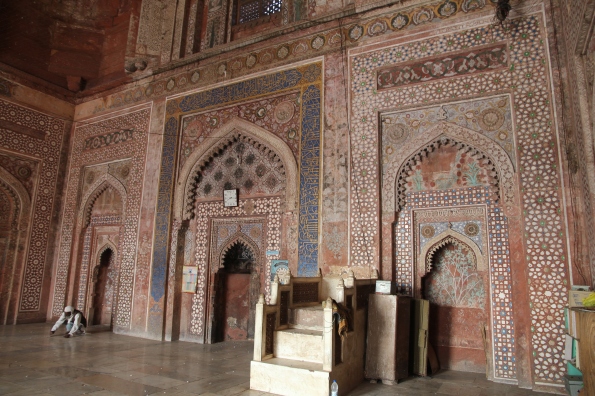Exploring the beauty of Fatehpur Sikri—an Indian ghost town
I’d never heard of it, had to learn how to spell and pronounce it, and fell completely in love with it. I’m referring to Fatehpur Sikri in Rajasthan. This architectural wonder isn’t so much a monument as a fabulous city, built in the 1500s by the Mughal emperor Akbar, who reigned over northern India.
The story goes that Akbar had twins who died. He pined for another heir and sought out a Sufi saint, Salim Chishti, who lived in a cavern near the Sikri area. The saint accurately predicted that the desired heir would be born soon.
Akbar was overjoyed when a male child was born in 1569 and named him, Salim, to honour the saint. Prince Salim grew up to become the emperor Jehangir. But when the lad was just two years old, Akbar returned to Sikri and began building the historic town of Fatehabad, later renamed Fatehpur Sikri. Fatehabad means city of victory and was meant to mark Akbar’s conquests over parts of Gujarat while the city was being built.
Sadly this dream city’s existence was short-lived. Within 15 years of Fatehabad being completed, the lake that was the community’s only natural source of water began to dry up. About that time, invaders from the northwestern frontier also began to arrive.
Ultimately, Fatehpur Sikri was abandoned and what visitors see today is virtually a ghost town—an architecturally divine ghost town.
So I want to show off some of the structures that make up this ancient city.
I’ll start where we started—in front of the massive Buland Darwaza, the main entrance to the complex. It stands 15 storeys high but, because it’s on a hill and up two long flights of stairs, it seems like a skyscraper.
After we made our way through the usual army of souvenir sellers and a herd of mischievous goats, we gazed in wonder at the Buland Darwaza’s elaborately carved sandstone and intricate inlay.
The portico has three arched entrances, with the largest one, in the centre, known locally as the Horseshoe Gate, after the custom of nailing horseshoes to its large wooden doors for luck.
Once through the doors, we stepped into a huge courtyard with fascinating structures all around.
It’s hard to know exactly what you’re looking at when buildings aren’t marked and images on the internet aren’t always accurately identified. I’m hoping my identifications are accurate, but let me know if they aren’t. I’ve left some images unnamed because I simply can’t be sure.
Structures include palaces, audience halls, the tomb of the saint Salim Chishti, a mosque, a mint, a treasury, a records office, a royal workshop, baths, stables, a caravanserai and living quarters . The architecture shows signs of Gujarat, Bengal, Jain and Islamic designs.
Salim Chishti’s tomb is a place of reverence and respect. It’s made of white marble and the tomb is embellished by acres of mother-of–pearl. As a sign of the tomb’s significance, we were expected to don small plastic hats to show our respect. A couple of men were binding handmade brooms while they dished out the little hats.
In recent times, devotees have given the tomb a big touristic tick. Similar to what we saw in Brazil, people are now tying small bits of coloured string or ribbon to the geometric windows surrounding the tomb. I assume this an effort to make wishes come true.
To the east is the tomb of Islam Khan I, Salim Chishti’s grandson who became a general in the Mughal army during the reign of Jehangir. His tomb is topped by a dome and 36 small domed chattris, and contains graves, some unnamed, of Salim Chishti’s male descendants.
The Jama Masjid (Jama mosque) was probably one of the first structures to be built, and it’s dated as being completed in 1571–72. It has a massive entrance, three mihrabs (niches) and decorations in white marble inlay with geometric patterns. Two fellows were at work when we passed through—one sweeping and the other scraping gunk off the floor. I think the mosque is the most impressive structure within the complex. It’s certainly my favourite.
It’s obvious that there’s a big effort to maintain and improve Fatehpur Sikri. There was scaffolding everywhere and none of that safety fencing to keep us from getting up close.
But no visit to a touristic site is complete without a visit to a souvenir seller. Luckily, some relatives of the guide/driver who had been hired for the day just happened to have a shop around the corner. Can’t complain, the prices were fair and the quality was good.
Next stop—the Taj Mahal.


































what an amazing place…have they found water yet? or do people commute ?
LikeLike
It is amazing. Today the Fatehpur Sikri area has a population of about 30,000. While there’s still no lake, I assume they have dug deep for water. Rajasthan is a notoriously dry state in India.
LikeLike
An incredible cultural, historic, and architectural treasure! Thanks for sharing it with us!
LikeLike
My pleasure indeed. The pictures transport me back there.
LikeLike
Stunning!
LikeLike
Now to get you and Russ there to see it for yourselves.
LikeLike
Having a good camera, the pictures show a very impressive and an interesting city, the architectural structures. The inlay also was interesting and lucky that people did not pick away at them, and sell the semi-precious gems. And the gift shop with the showcase of items, got my attention as well.
LikeLike
Good point about the semi-precious gems in the inlay. We saw other monuments that had big gaps where gems had been stolen.
LikeLike
Excellent photographs Peggy. I love old doors and gateways, there is something mysterious about them. Like ancient steps which have been worn down by countless millions of feet. Love your blog 🙂
LikeLike
Thanks Kenny, I like doors and gateways too. You’ve reminded me that I should add them as tags. So glad you’re enjoying the blog.
LikeLike